 |
||
|
||
| ||
ELSA company has entered world market not so long ago, though in Germany (and even in Europe) it's well-known for its monitors and video cards. For a long time the company specialized in rather expensive professional video cards, and only 2 years ago it flowed into mainstream market. Unfortunately, its products cost much, that's why it makes difficult to compete against products of asian background. However, we should notice that ELSA ensures high quality reliable products, flawless drivers and good guarantee. ELSA is proud that it uses only selected components which were carefully tested in their labs. Despite their costy professional cards, game video cards from ELSA are already comparable with their competitors, and the cards for cheap market cost within the bounds of "noname" cards. For example, ELSA Gladiac MX is promised to be around $115-120. Some time ago we considered a couple of video cards based on GPU NVIDIA GeForce2 MX. The cards of this class are intended for a sector of relatively cheap computer systems, though they possess everything for comfort work and games. So, we continue examining serial video cards based on NVIDIA GeForce2 MX, which are already available. The main feature of GeForce2 MX is 2 times decreased performance in 3D (i.e. 2 instead of 4 three-dimensional rendering pipelines, and 175 MHz against 200 MHz of GeForce2 GTS). Though the saddest thing is a relatively slow SDR-memory. When we wrote about GeForce 256 based cards with SDR, we mentioned that the bandwidth of video cards is a major bottleneck. Whatever powerful a graphics processor is, it can't realize what it's capable of with a slow video memory. When I considered NVIDIA GeForce2 GTS based video cards, disbalance of such boards exasperated me. Remember specs of NVIDIA GeForce 256 SDR? The chipset worked at 120 MHz, the memory was at 166 MHz. Today GeForce2 MX' core works at 175 MHz, and the memory keeps those 166 MHz. You see that the disbalance of such cards is even more higher. That's why we think that speed results of GeForce2 MX based boards would turn to be close to that of GeForce 256 SDR. First of all it concerns 32-bit color, for which a video memory's bandwidth appears the greatest bottleneck. But the slow memory makes the cards relatively cheap. Moreover, NVIDIA GeForce2 MX based video cards feature 2D-graphics of higher quality unlike GeForce256 SDR based boards; besides, they support such things as TwinView technology etc. In general, I can't give all GeForce2 MX based cards the same mark, since it depends on the definite sample. BoardELSA Gladiac MX specs:
There you can see the card itself: 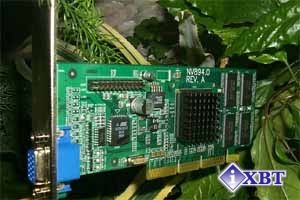 Te card is equipped with AGP2x/4x interface, 32 MBytes 6 ns SDR SDRAM located in 4 chips on the right side of PCB: 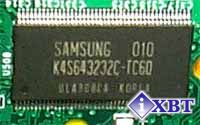 The chips of memory are produced by Samsung and works at 166 MHz. The appearance of this video card follows in detail reference card from NVIDIA. Besides, now ELSA simply uses production facilities of VisionTech making an OEM order and than sticks labels with their logo on the cards. Just like in case of Inno3D Tornado GeForce2 MX, I couldn't help surprised with size of this board! Not so long time ago such little PCB had only VGA-cards from Realtek with 256 KB on board. The board lacks for a fan, there is just a small heat sink. To all appearances, NVIDIA recommends all manufacturers to use only heat sinks since there is no much overheat of the chip. The board is dark green. PCB provides a blank space for a jack for digital monitors. What we managed to get was only OEM-variant, that's why there is nothing to say about the complete set. Though judging by other reviews, the board is shipped in a standard ELSA box with a usual set: user's manual, CD with drivers and utilities, several CDs of advertising nature. OverclockingUnlike NVIDIA GeForce256 SDR based video cards with 5 ns memory chips which work at underfrequency of 166 MHz, ELSA Gladiac MX is equipped with 6 ns memory chips working at its rated frequency (166 MHz). We managed to make it work at 210 MHz. The graphics core was overclocked up to 210 MHz (and this with 175 MHz!), what proves good potential of these chips built on 0.18 micron technology. There is every reason to expect some performance gain when at high frequencies in 32-bit color, and considerable increase in 16-bit color. Installation and driversNow comes a practical part of our review. First our testbed:
The company supplies its own drivers though they are based on the reference ones from NVIDIA. We'll consider the drivers more in depth since some settings are not standard. Unfortunately, ELSA hasn't released yet drivers based on Detonator3-series (6.* version), that's why some functions of GeForce2 MX (i.e. DVC) can't be enabled. The considered version is based on reference driver 5.33. 2D-graphics settings offer a wide choice, what set ELSA's drivers apart: 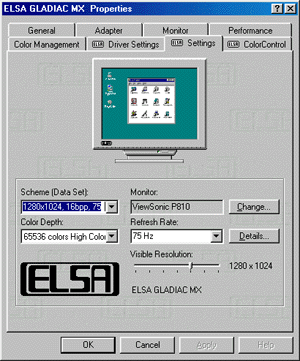 Color settings can be adjusted independently: 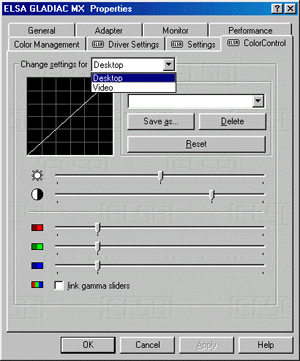 3D-graphics setting don't differ much from reference drivers: 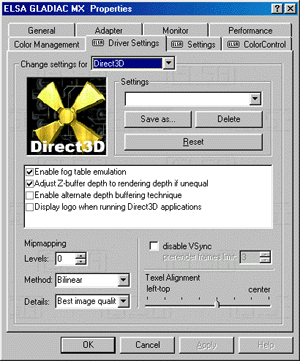  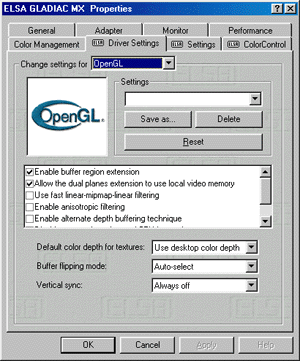 The drivers contain an integrated utility for overclocking the card: 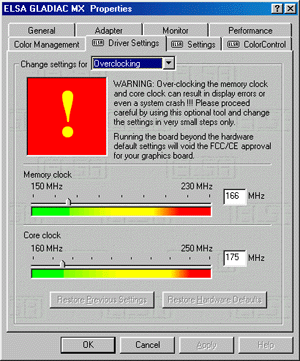 Test resultsLet's start with 2D-graphics. Earlier I stressed on perfect quality and decent speed in 2D-graphics which were shown by GeForce2 MX based cards from NVIDIA. And now I can state that ELSA Gladiac MX card demonstrates results far not worse than other cards of this class (there tells upon a full copied reference design from NVIDIA). I'm sure that ELSA Gladiac MX video card along with other representatives of such boards will provide quality image for most users. The following 2 games will help us to estimate speed rates of ELSA Gladiac MX in 3D-graphics:
With these tools we will show you the video card performance via two main API. Beside this card, there are diagrams for three other video cards: ELSA ErazorX (based on NVIDIA GeForce256 SDR), reference card NVIDIA GeForce2 MX and Creative 3D Blaster GeForce256 Annihilator Pro (based on NVIDIA GeForce256 DDR). Then, you may see the performance change of ELSA Gladiac MX while overclocking. 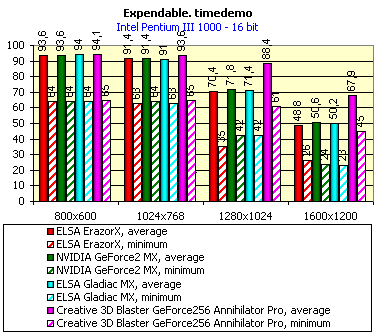 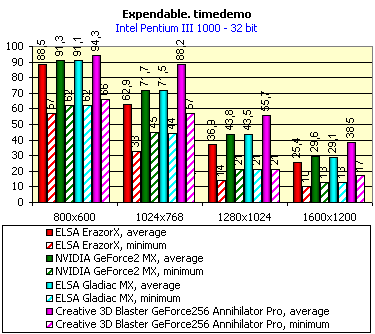 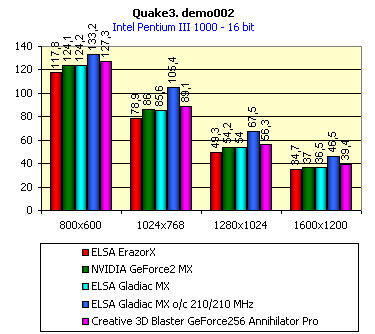 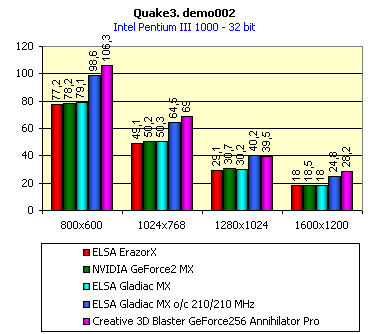 It's easy to notice that performance results of ELSA Gladiac MX video card correspond in general to the reference card's results on NVIDIA GeForce2 MX. Gladiac MX beat its NVIDIA GeForce256 SDR based contestant by a small margin, and lags behind GeForce256 DDR based board. These result were expected because of a slow video memory. Even overclocking of ELSA Gladiac MX couldn't make this board a leader in 32-bit color. But in 16-bit color mode the overclocked ELSA Gladiac MX could beat all its contestants. Note that ELSA card worked with minimum additional cooling (there was only one additional fan in the system block). Well, of cause I can't generalize the results of this definite card on all GeForce2 MX based boards. As for DVD-Video, it's similar to all video cards on NVIDIA GeForce2 GTS. An installed InterVideo WinDVD 2.1 player worked flawlessly with the board, image quality was marvelous, processor load didn't exceed 27%. Since ELSA Gladiac MX doesn't have the second output for an external signal receiver (second monitor, TV-out, DVI), we didn't pay attention to TwinView technology. ConclusionWell, Gladiac MX card is a bright specimen of the cards from ELSA on the base of latest GPU NVIDIA GeForce2 GTS/MX. As tests show, this card yields to no one of its analogs. Despite the fact that its performance in most cases corresponds to level of NVDIA GeForce256 SDR or a little more, the card costs relatively cheaper. Besides, don't forget increased 2D quality as compared with NVIDIA GeForce256, and additional goodies thanks to DVC technology. Pros:
Cons:
Write a comment below. No registration needed!
|
Platform · Video · Multimedia · Mobile · Other || About us & Privacy policy · Twitter · Facebook Copyright © Byrds Research & Publishing, Ltd., 1997–2011. All rights reserved. |